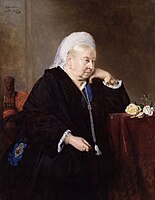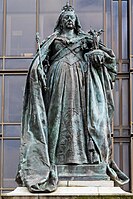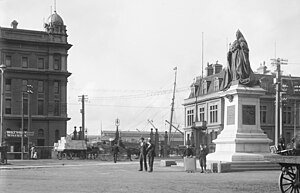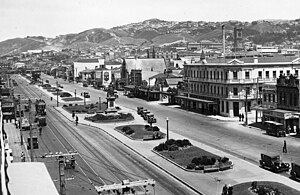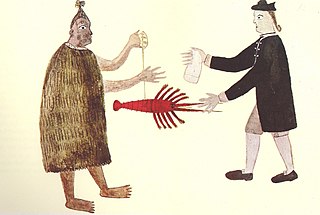
The Treaty of Waitangi, sometimes referred to as Te Tiriti, is a document of central importance to the history of New Zealand, its constitution, and its national mythos. It has played a major role in the treatment of the Māori people in New Zealand by successive governments and the wider population, something that has been especially prominent from the late 20th century. The treaty document is an agreement, not a treaty as recognised in international law, and has no independent legal status, being legally effective only to the extent it is recognised in various statutes. It was first signed on 6 February 1840 by Captain William Hobson as consul for the British Crown and by Māori chiefs from the North Island of New Zealand.

Waitangi Day, the national day of New Zealand, marks the anniversary of the initial signing—on 6 February 1840—of the Treaty of Waitangi. The Treaty of Waitangi was an agreement towards British sovereignty by representatives of the Crown and indigenous Māori chiefs, and so is regarded by many as the founding document of the nation.

Sir Joseph Edgar Boehm, 1st Baronet, was an Austrian-born British medallist and sculptor, best known for the "Jubilee head" of Queen Victoria on coinage, and the statue of the Duke of Wellington at Hyde Park Corner. During his career Boehm maintained a large studio in London and produced a significant volume of public works and private commissions. A speciality of Boehm's was the portrait bust; there are many examples of these in the National Portrait Gallery. He was often commissioned by the Royal Family and members of the aristocracy to make sculptures for their parks and gardens. His works were many, and he exhibited 123 of them at the Royal Academy from 1862 to his death in 1890.

The monarchy of New Zealand is the constitutional system of government in which a hereditary monarch is the sovereign and head of state of New Zealand. The current monarch, King Charles III, acceded to the throne following the death of his mother, Queen Elizabeth II, on 8 September 2022 in the United Kingdom. The King's elder son, William, Prince of Wales, is the heir apparent.

Dame Whina Cooper was a respected kuia, who worked for many years for the rights of her people, and particularly to improve the lot of Māori women. She is remembered for leading the 1975 Māori land march from Te Hāpua to Wellington, a distance of 1,100 km (680 mi), at the age of 79.
Claims and settlements under the Treaty of Waitangi have been a significant feature of New Zealand politics since the Treaty of Waitangi Act 1975 and the Waitangi Tribunal that was established by that act to hear claims. Successive governments have increasingly provided formal legal and political opportunity for Māori to seek redress for what are seen as breaches by the Crown of guarantees set out in the Treaty of Waitangi. While it has resulted in putting to rest a number of significant longstanding grievances, the process has been subject to criticisms including those who believe that the redress is insufficient to compensate for Māori losses. The settlements are typically seen as part of a broader Māori Renaissance.

Moutoa Gardens, also known as Pākaitore, is a park in the city of Whanganui, New Zealand. Named after the Battle of Moutoa Island in the Second Taranaki War, it contains a memorial to the battle inscribed "To the memory of the brave men who fell at Moutoa, 14 May 1864, in defence of law and order against fanaticism and barbarism." It also contained a statue of John Ballance, organiser of a volunteer cavalry troop in Tītokowaru's War and later Premier of New Zealand, but the statue was beheaded and a replacement installed outside the district council building. A number of items present in the park are registered by Heritage New Zealand.

Dame Claudia Josepha Orange is a New Zealand historian best known for her 1987 book The Treaty of Waitangi, which won 'Book of the Year' at the Goodman Fielder Wattie Book Award in 1988.
The Māori protest movement is a broad indigenous rights movement in New Zealand. While there was a range of conflicts between Māori and European immigrants prior to the signing of the Treaty of Waitangi in 1840, the signing provided one reason for protesting. Disagreements in the decades following the signing sometimes included war.
1840 is considered a watershed year in the history of New Zealand: The Treaty of Waitangi is signed, British sovereignty over New Zealand is proclaimed, organised European settlement begins, and Auckland and Wellington are both founded.
The law of New Zealand uses the English common law system, inherited from being a part of the British Empire.
Edward Alfred Briscoe Drury was a British architectural sculptor and artist active in the New Sculpture movement. During a long career Drury created a great number of decorative figures such as busts and statuettes plus larger monuments, war memorials, statues of royalty and architectural pieces. During the opening years of the 20th-century he was among the foremost architectural sculptors active in Britain and in that period created the series of works in central London for which he is perhaps now best known. These include the figures on the Old War Office building in Whitehall, elements of the facade of the Victoria and Albert Museum and four of the colossal statues on Vauxhall Bridge.

The Colony of New Zealand was a colony of the United Kingdom of Great Britain and Ireland that encompassed the islands of New Zealand from 1841 to 1907. The power of the British Government was vested in the governor of New Zealand. The colony had three successive capitals: Okiato in 1841; Auckland from 1841 to 1865; and Wellington from 1865, which continues as the capital of New Zealand today.

The equestrian statue of the Duke of Wellington is an outdoor sculpture of Arthur Wellesley, 1st Duke of Wellington, a British soldier and statesman, located at the Royal Exchange in London. It overlooks Bank junction in the historic City of London. The sculptor was Francis Leggatt Chantrey. The statue commemorates Wellington's assistance to the City of London in ensuring that a bill was passed to allow the rebuilding of London Bridge.

A bronze statue of Captain John Fane Charles Hamilton was installed for seven years, in Hamilton, New Zealand, from in 2013 until removal in June 2020.
The Statue of Queen Victoria stands on the sea front at the bottom of Grand Avenue in Hove on the south coast of England. The statue is one of 14 by Thomas Brock and was unveiled in February 1901, the month after Queen Victoria's death. It is a grade II listed building.

The New Zealand penny is a large bronze coin issued from 1939 to 1965. Introduced seven years after the larger denominations of New Zealand pound coinage, the coin's issuing was scheduled to align with the centennial of the Treaty of Waitangi and the New Zealand centennial, alongside the halfpenny and centennial half-crown. Featuring the standard portrait of the ruling monarch on the obverse, the reverse features a tūī bird perched atop a kōwhai branch.

A statue of Queen Victoria was erected at Albert Park, Auckland, in 1899. The second monument to Queen Victoria in New Zealand, the bronze statue was funded by public donations encouraged by Auckland politicians and the New Zealand Herald in celebration of the Queen's Diamond Jubilee. Following applications from various British and New Zealand artists, the statue was commissioned to British portrait sculptor Francis John Williamson. It was one of nine variants of his 1887 statue erected at the Royal College of Surgeons, allegedly a favourite of the future Edward VII.

The Stuart Memorial is a statue of clergyman Donald McNaughton Stuart located in central Dunedin, New Zealand. It sits adjacent to Queens Gardens, close to a statue of Queen Victoria. The memorial is a bronze statue of Stuart seated in a solemn pose, atop a large concrete, granite, and andesite plinth. Stuart was a locally renowned minister, educationalist, and community leader, and shortly after his death in 1894, a memorial committee was established. After several months of community fundraising, the committee contracted Wellington-based artist William Leslie Morison to model the statue, the first major civic commission given to a New Zealand artist. With a plaster model by Morison used as the base, the statue was cast at the Moore foundry near London.

The statue of Queen Victoria is a large bronze statued of Queen Victoria in Victoria Square, Christchurch. Sculpted by British artist Francis John Williamson, it was erected in 1903 as a monument to the Queen as well as the settlement of the Canterbury Province and a memorial to soldiers fighting in the South African wars.


